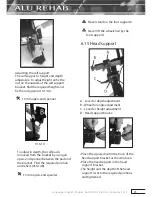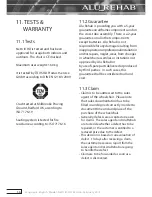
27
Language: English Model: Netti III HD Version: February 2013
7. TRANSPORT
Netti III HD is tested and approved to crash
test ISO 7176-19.
7.1 Folding for transport
When wheelchair is unoccupied, fold as
described below. Put wheelchair in trunk or
back seat. When placed in back seat, secure
frame using safety belt.
• Remove head support (chapt. 6.15)
• Turn anti tips up (chapt. 6.10)
• Swing push handles in (chapt. 6.16)
• Remove arm supports (chapt. 6.11)
• Remove foot supports (chapt. 6.14)
• Remove backrest cushion (chapt. 6.12)
• Release backrest and fold it (chapt. 6.7)
• Remove main wheel (chapt. 6.2)
• Remove front castor (chapt. 6.4)
7.2 Transport in car
If the head support is mounted correctly
it is very stable but does not replace the
need for an external neck support mounted
in the car.
The chair is marked with stickers in 4
positions, showing where to fix the straps
Netti III HD has been successfully tested
according to the requirement of ISO
7176-19 using a combined wheelchair
an occupant restraint system W120/DISR
developed by Unwin Safety Systems. For
further information: www.unwin-safety.com
6.18 Seat angle / tilt
The seat angle is regulated using the release
handle mounted on the push bar.
The seat unit can be tilted from -11° to +14°.
6.19 Back rest angle
The back rest angle is regulated using the
release handle mounted on the push bar. The
angle can be regulated from 4° forward to 40°
backwards.
To ensure correct function of the
wires, these must never be taut.
The seat and back rest angle must not
be adjusted without using the anti tips.
The release handle has the following label:
Tilt
Recline
Risk for tipping.
Check the position of anti tip.














































